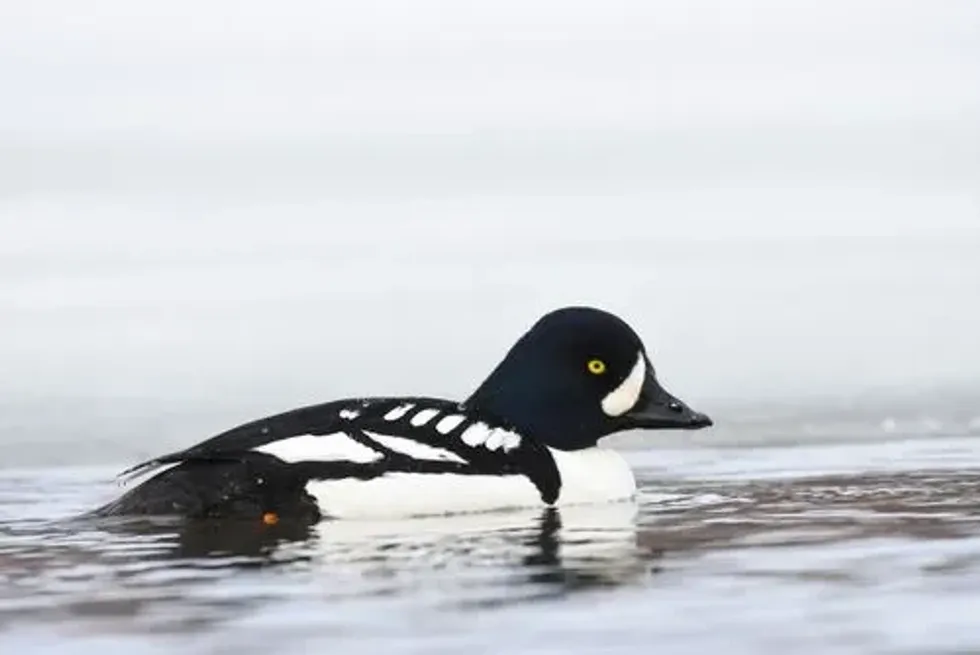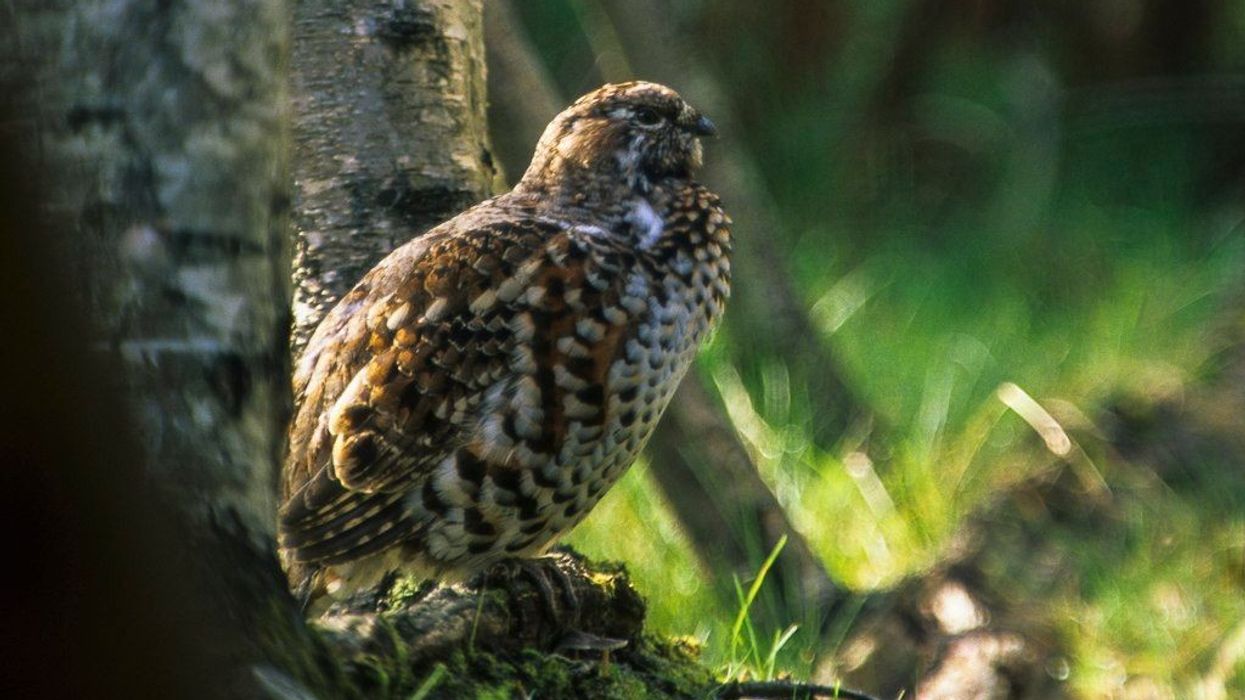A Barrow's goldeneye (Bucephala islandica) is a majestic-looking sea duck named after the famous English geographer, Sir John Barrow. The range map of these birds includes the Rocky Mountains in North America, northeastern North America, Greenland, and Iceland.
The eastern and western populations are distributed throughout the Atlantic and Pacific coasts. The birds take part in migration to undergo molting. Their migration range is a short distance and takes place in late fall and early spring.
In appearance, they bear a close resemblance to common goldeneyes. Their crescent-shaped white patch on their dark head is a distinctive feature that can help to differentiate them from common goldeneyes.
These ducks are pro divers, and large flocks dive together in North American lakes at the same time. They spend most of their time swimming, perching, flying, and foraging a wide variety of aquatic organisms with flocks of different waterfowl species.
During the winter, males can be found gathered around females performing various courtship displays like head-turning, rotary-pumping, and head-flicking. Females also reciprocate by performing distinctive head motions using their yellow bills.
These birds are one of the most fascinating sea ducks, and there is a lot to learn about them. Keep reading to learn more interesting facts about these primarily North American birds to find their locations easily on the map.
If you like reading about different birds, be sure to check out Robin and Bearded vulture facts too.
Barrow's Goldeneye Interesting Facts
What type of animal is a Barrow's goldeneye?
A Barrow's goldeneye (Bucephala islandica) is a type of sea duck.
What class of animal does a Barrow's goldeneye belong to?
Barrow's goldeneyes belong to class Aves and the family of geese and swans called Anatidae.
How many Barrow's goldeneyes are there in the world?
There has not been enough research and studies conducted to calculate the total population of these diving ducks in the world.
Where does a Barrow's goldeneye live?
The range map of this bird is quite diverse. The majority of Barrow's goldeneye population range can be found in northwestern North America. You can also come across these pretty sea birds in parts of eastern Canada.
In Canada, they are most commonly found in Quebec. The eastern and western populations can be found on the coast of the Atlantic and Pacific. A distinct breeding population can also be located around the Columbia Basin.
What is a Barrow's goldeneye's habitat?
During breeding, a Barrow's goldeneye can be seen swimming away in freshwater and small alkaline lakes, beaver ponds, and rivers near mature boreal forests. In the winter season, their habitat consists of protected coastal waters like estuaries and bays.
Their wintering season habitats range from southeastern Alaska to central California. These birds prefer shallow and slow-flowing, ice-free waters but can also be found foraging in areas with strong currents.
Who do Barrow's goldeneyes live with?
Barrow's goldeneyes form flocks and forage together to search for prey. During migration, these flocks gather with other groups and form a large flock at their rest sites. Barrow's goldeneyes can also be found foraging not just with their species but with many other types of ducks.
How long does a Barrow's goldeneye live?
The Barrow's goldeneye species have a long lifespan, and this is largely dependent on the availability of food and the stability of their environment. The oldest known Barrow's goldeneye was 18 years old. In the wild, their lifespan is approximately 15 years.
How do they reproduce?
The Barrow's breeding season is in the winter. Breeding pairs are formed during late winter or early spring.
Drakes perform various physical displays and vocalizations during courtship such as holding their heads high up then swinging them backward with their vertically pointed bill, and lifting their head up and down with their straight neck.
A female Barrow's goldeneye breeds when she is three years of age but keeps a lookout for prospective nesting spots around trees from an early age.
A Barrow's goldeneye breeds on shallow freshwater lakes. Their nesting is mostly situated in hollowed-out cavities in trees near lakes and rivers. At times, they also use readily available artificial nest boxes for breeding.
The nests are lined with the breast feathers of the duck. A female lays about six to 12 olive-green or blue-green eggs.
The incubation period lasts for 29 to 31 days. Young ducklings are well-developed when they hatch from the eggs, and these young hatchlings leave the nesting shortly after they hatch.
What is their conservation status?
The Barrow's goldeneye population has been given the conservation status of Least Concern by the International Union for Conservation of Nature or IUCN.
Barrow's Goldeneye Fun Facts
What do Barrow's goldeneyes look like?
Barrow's goldeneyes are chunky-bodied sea ducks with large heads and short necks. They belong to the same family of swans and geese. females have gray bodies with bright yellow eyes, brown heads, and a yellow bill.
Adult drakes have distinct crescent white patches present on their black head with a purplish sheen. Their jet-black back, wings, and tail are a great contrast to their dazzling white breast, belly, and secondary feathers. Both males and females have small, triangular bills.
How cute are they?
The contrasting colors of black and white on their body with vibrant golden eyes makes Barrow's goldeneyes appear to be majestic and extremely pleasing to look at.
How do they communicate?
During the courtship period and the breeding season, drake goldeneyes communicate with their female counterparts by calling them 'ka-kaa'. The female responds in soft notes, making the 'cuc' sound. While flying, the swift movements of their wings result in a soft whistling sound. Like swans and geese, they also take the help of visual signals to demonstrate aggression.
How big is a Barrow's goldeneye?
An adult male Barrow's goldeneye is approximately 19.2 in (49 cm) long, and the female is 17 in (43 cm) long. The wingspan is about 27.6-28.7 in (70.1-73 cm) long.
How fast can a Barrow's goldeneye fly?
There has not been enough research conducted to calculate their flight speed. However, their flight is swift with strong wing beats, and they can fly through dense, bushy forests with great ease.
How much does a Barrow's goldeneye weigh?
Adult Barrow's goldeneye drakes are heavier than hens and weigh about 2.13 lb (0.97 kg), whereas the latter weighs in the range of 1.31 lb (0.51 kg).
What are the male and female names of the species?
Male Barrow's goldeneye ducks can be referred to as drakes, and females of this species are known as hens.
What would you call a baby Barrow's goldeneye?
A baby Barrow's goldeneye duck is known as a duckling.
What do they eat?
This diving duck's food habits are heavily dependent on its habitat, season, and region. Their diet has been observed to consist of a variety of aquatic organisms like mussels, crustaceans, algae, and snails and also includes some vascular plants. In the spring, salmon, and herring fish eggs constitute the majority of their diet.
Are they dangerous?
This species of diving duck is not known to be a dangerous animal. Barrow's goldeneyes face a threat from humans hunting them during the fall and winter hunting seasons.
Would they make a good pet?
Barrow's goldeneyes can make for an amusing pet. Sea ducks, however, like Barrow's goldeneyes and common goldeneyes, should not be kept as pets in apartments as providing them with their ideal habitat and temperature would prove to be difficult.
Did you know...
The Barrow's goldeneyes species are defensive when it comes to their broods or territory.
Barrow's goldeneyes bear a close resemblance to common goldeneyes. One way to differentiate between them is to search for the distinct 'crescent-shaped' white patch. Their bill is also smaller in size compared to the bill of a common goldeneye.
People residing near Lake Mývatn in Iceland create nest boxes for these birds, as a result of which, the populations of Barrow's goldeneye are thriving there.
Are Barrow's goldeneyes a species of duck?
The Barrow's goldeneye species are a type of sea duck belonging to the genus Bucephala. It is a common wild duck. Goldeneyes are ducks and belong to the same family of swans and geese, Anatidae.
Do ducks recognize humans?
Ducks have the same five senses that humans have, and the most notable of these five is their vision. They are heavily dependent on their sight.
The structure of their eye is such that they can look at objects in minute detail, two to three times farther away than human beings can. They can also fathom a broader spectrum of colors and have a panoramic vision.
Ducks are very social and can recognize humans if they have imprinted on them. If a human has raised a flock of birds, they will recognize the human being as their own.
Here at Kidadl, we have carefully created lots of interesting family-friendly animal facts for everyone to discover! Learn more about some other birds including flamingos or tufted titmice.
You can even occupy yourself at home by drawing one on our barrow's goldeneye coloring pages.










